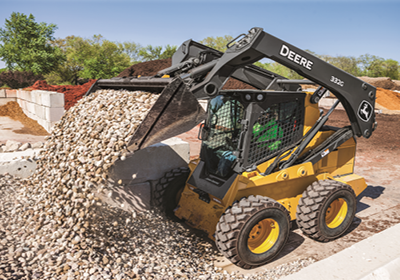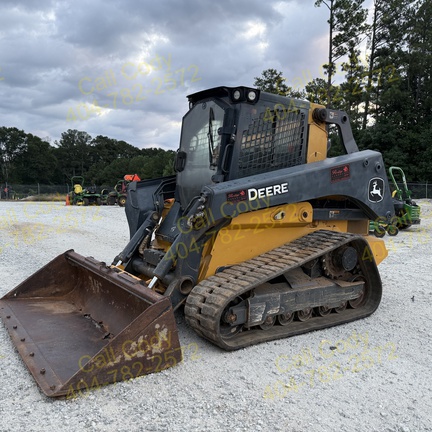What Is the Purpose of a Skid Steer?
Skid steers are compact, versatile machines widely used across industries for diverse tasks. In construction, they excel in excavating, grading, demolition, and material handling. In landscaping, they clear land, prepare soil, and trench. Agriculture utilizes them for feeding livestock, barn cleaning, and material transport. Skid steers also play roles in snow removal, forestry, roadwork, utility work, and waste management. Their adaptability is further enhanced by a range of attachments like buckets and augers, making them indispensable in various applications.
What’s the Difference Between a Track Skid Steer and a Wheel Skid Steer?
The primary differences between a track skid steer and a wheel skid steer lie in their undercarriage design, performance, and suitability for various terrain conditions.
Track Skid Steer
Undercarriage Design: Uses rubber tracks instead of wheels.
Traction and Stability: Offers better traction and stability on soft, uneven, muddy, or snowy terrain due to the increased ground contact area.
Ground Pressure: Distributes weight more evenly, resulting in lower ground pressure, which reduces soil compaction and is gentler on delicate surfaces.
Durability and Maintenance: Generally more durable for harsh conditions but can be more expensive to maintain due to potential track wear and the need for regular track tension adjustments.
Applications: Ideal for rough or sensitive ground conditions, such as construction sites with loose soil, wet or muddy areas, and landscaping tasks.
Wheel Skid Steer
Undercarriage Design: Equipped with four wheels.
Maneuverability: Provides better maneuverability on hard, flat surfaces due to the ability to make tighter turns.
Speed: Typically faster on solid ground, making them more efficient for tasks that require a lot of movement across a site.
Ground Pressure: Exerts higher ground pressure, which can lead to soil compaction and is less suitable for soft or sensitive surfaces.
Durability and Maintenance: Easier and less expensive to maintain, with fewer issues related to undercarriage components compared to tracked versions.
Applications: Best for solid and stable surfaces like concrete, asphalt, and hard-packed soil, making them suitable for urban construction, roadwork, and tasks where high speed and maneuverability are essential.
Should I Choose a Track Skid Steer or a Wheel Skid Steer?
The choice between a wheel skid steer and a track skid steer depends largely on the specific job requirements and the terrain where the machine will be used. Wheel skid steers are preferable for solid surfaces and applications requiring speed and maneuverability, while track skid steers are better suited for soft, uneven, or sensitive terrain.
Video: Tracked vs. Wheeled Skid Steer | How To Choose??

Popular Brands of Skid Steers for Sale
Bobcat | CAT | Kubota | John Deere | Toro | New Holland | Case
What Should I Consider When Buying a Used Skid Steer for Sale?
When buying a skid steer, there are many options to consider. Key factors to look at for a used skid steer are usage, maintenance records, engine condition, and hydraulic system. Looking at the hours and learning where the machine was used can help extend your use of a used machine. Making sure it turns with no hesitation, no smoke coming from the engine, no cracks on the machine, no rust, and making sure all hydraulic systems operate smoothly.
Why Do They Call It a Skid Steer?
Skid steer refers to a compact, maneuverable piece of construction equipment with the ability to turn within its own footprint. Skid steers do not have the traditional steering mechanism. While only able to operate in straight lines, turning the machine is performed by applying the brakes to only one side of the machine, which causes skidding. The skidding on the ground is where the name skid steer comes from.
Should I Buy a New or Used Skid Steer for Sale?
When considering purchasing a skid steer, several factors need to be considered: budget, warranty, attachments, location, and hours. If you are looking for a warranty, the latest technology, and a longer lifespan, a new skid steer for sale might be the route to go. If you are looking for immediate availability, lower cost, and performance of the machine, it could be for you! Having wear and tear on the machine will lower the cost of the skid steer. If you need one immediately, a used skid steer will be the best option due to the abundance available.
How Much Does a Skid Steer Weigh?
Three common variations of skid steers are compact, midsize, and large frame. The “compact skid steer” weighs around 2,500-7,000 pounds. Medium or “midsize” are a little heavier, around 7,000-10,000 pounds. The large or “heavy-duty” skid steers weigh 10,000-12,000 pounds. Make, model, and attachments all play factors in the weight of the machine.
What Types of Skid Steer Attachments Are Available?
Skid steers, being highly versatile machines, come with an array of attachments. Skid steer attachments for sale include buckets, augers, forks, grapples, trenchers, loader arms, hydraulic breakers, sweepers, mulchers, snow blowers, and other items. Having the ability to have all these capabilities makes a skid steer a great addition to your fleet. FleetNow has many options to make your skid steer suitable for many working conditions. Check out our Skid Steer Attachments For Sale on BuyFleetNow.com.
Recent Equipment News
MEC MME25 Review: Specs, Features & Industry Perspective
MEC MME25 Review: Specs, Features & Industry [...]
Help Name FleetNow’s New Rental Platform—Get a Free Shirt That’ll Turn Heads on the Jobsite
A new rental + inventory platform is coming–built by [...]
Construction Equipment Trends 2025: Inside Q1–Q2 Demand & What It Means for You
Table of Contents Top 10 Categories Q1 vs [...]












































